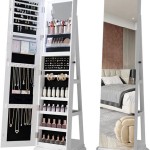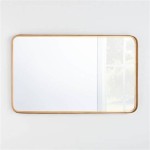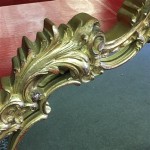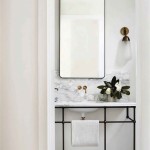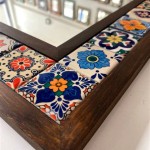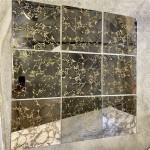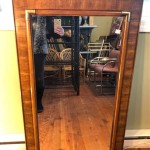The Enduring Elegance of Silver Mirror Frames
Silver mirror frames represent a sophisticated and timeless addition to any interior design. Their reflective qualities enhance both the mirror itself and the surrounding décor, offering a blend of functionality and aesthetic appeal. These frames have graced homes and establishments for centuries, evolving through various styles and craftsmanship techniques, yet consistently maintaining an aura of refined elegance.
The appeal of silver mirror frames lies in their ability to complement a wide array of interior styles. From classic and traditional to modern and minimalist, a silver frame can seamlessly integrate into different design schemes. The inherent versatility of silver allows it to pair well with various color palettes, textures, and materials, making it a favored choice among interior designers and homeowners alike.
Beyond their aesthetic properties, silver mirror frames also possess practical benefits. Silver is a relatively durable metal, offering protection to the mirror's edges and preventing damage from minor impacts. Furthermore, the reflective surface of the frame itself contributes to the overall illumination of the room, creating a brighter and more inviting space. The longevity and functional advantages, coupled with the inherent beauty, make silver mirror frames a worthwhile investment for enhancing any environment.
Historical Significance and Evolution
The use of silver in mirror frames dates back centuries, mirroring the historical significance of silver itself as a precious and revered metal. In earlier periods, silver was often associated with wealth and status, making silver-framed mirrors a symbol of luxury and sophistication. These pieces were frequently commissioned by the aristocracy and displayed prominently in their homes, reflecting their opulence and refined taste.
The styles and designs of silver mirror frames have evolved alongside changing artistic movements and societal preferences. During the Baroque and Rococo periods, frames were characterized by elaborate ornamentation, intricate carvings, and the use of precious stones. These frames often featured floral motifs, scrollwork, and other decorative elements that emphasized grandeur and extravagance. The silver itself was often expertly crafted with techniques such as repoussé and chasing to create dynamic three-dimensional effects.
As design sensibilities shifted towards simpler and more functional forms, silver mirror frames also underwent a transformation. The Victorian era witnessed a blend of ornate detailing and more restrained designs, often incorporating botanical patterns and geometric shapes. The Arts and Crafts movement, with its emphasis on handcrafted quality and natural materials, influenced the creation of silver frames with clean lines and subtle embellishments. The Art Deco period introduced geometric patterns, streamlined shapes, and the use of contrasting materials, resulting in silver frames that exuded a sleek and modern aesthetic. In contemporary designs, silver mirror frames often feature minimalist forms, emphasizing the beauty of the metal itself without excessive ornamentation.
The historical evolution of silver mirror frames showcases the enduring appeal of this material and its adaptability to different design trends. From the opulent creations of the Baroque era to the minimalist designs of today, silver remains a timeless choice for enhancing the beauty and functionality of mirrors.
Craftsmanship and Materials
The quality and beauty of a silver mirror frame are significantly influenced by the craftsmanship involved in its creation. Skilled silversmiths employ a range of techniques to shape, decorate, and finish the silver, resulting in frames that are both visually stunning and structurally sound. The choice of materials also plays a crucial role in determining the overall aesthetic and durability of the piece.
Traditional silversmithing techniques include hammering, soldering, chasing, and repoussé. Hammering involves shaping the silver by carefully striking it with a hammer, gradually creating the desired form. Soldering is used to join different pieces of silver together, creating intricate designs and reinforcing the frame's structure. Chasing and repoussé are decorative techniques that involve creating raised or recessed patterns on the silver surface. Chasing is done from the front of the piece, while repoussé is executed from the back, resulting in unique three-dimensional effects.
Modern techniques such as casting and electroplating are also employed in the production of silver mirror frames. Casting involves pouring molten silver into a mold, allowing for the creation of complex shapes and intricate details. Electroplating is a process where a thin layer of silver is deposited onto a base metal, such as copper or brass. This technique allows for the creation of affordable silver-toned frames without the cost of using solid silver.
The type of silver used in the frame also varies. Sterling silver, which is an alloy containing 92.5% silver and 7.5% other metals (typically copper), is a common choice due to its durability and tarnish resistance. Fine silver, which is 99.9% pure silver, is softer and more susceptible to damage but offers a brighter and more reflective surface. Silver-plated frames typically consist of a base metal coated with a thin layer of silver, offering a more affordable alternative to solid silver frames although they are more prone to tarnishing over time.
The combination of skilled craftsmanship and high-quality materials ensures that silver mirror frames are not only aesthetically pleasing but also durable and long-lasting. The choice of techniques and materials depends on the desired aesthetic, budget, and intended use of the frame.
Design Considerations and Applications
When selecting a silver mirror frame, several design considerations come into play, including the size and shape of the mirror, the style of the surrounding décor, and the desired aesthetic effect. The applications of silver mirror frames are diverse, ranging from residential settings to commercial spaces, each requiring careful consideration of the overall design scheme.
The size and shape of the mirror should be carefully considered when choosing a frame. A large mirror in a spacious room can accommodate a more substantial and ornate frame, while a smaller mirror in a tighter space may benefit from a simpler and more streamlined design. The shape of the mirror should also complement the frame; a circular mirror might pair well with a round or oval frame, while a rectangular mirror could be enhanced by a rectangular or square frame.
The style of the surrounding décor should also influence the choice of frame. A traditional or classic interior might benefit from a frame with intricate carvings, floral motifs, or an antique finish. A modern or minimalist space might be better suited to a frame with clean lines, geometric shapes, or a high-gloss finish. The goal is to create a cohesive and harmonious look that complements the overall design scheme.
Silver mirror frames can be used in a variety of applications, including bathrooms, bedrooms, living rooms, and entryways. In bathrooms, they can add a touch of elegance and sophistication to the vanity area. In bedrooms, they can create a focal point above a dresser or headboard. In living rooms, they can enhance the overall ambiance and reflect light, making the space appear larger and brighter. In entryways, they can provide a welcoming and stylish touch, creating a positive first impression.
Commercial spaces such as hotels, restaurants, and boutiques can also benefit from the use of silver mirror frames. In hotels, they can add a touch of luxury and elegance to guest rooms and common areas. In restaurants, they can enhance the ambiance and create a more sophisticated dining experience. In boutiques, they can showcase merchandise and create a visually appealing shopping environment.
Ultimately, the design considerations and applications of silver mirror frames are highly versatile, allowing for a wide range of creative possibilities. By carefully considering the size, shape, style, and intended use of the frame, it is possible to create a stunning and functional addition to any space.

Silver Gunmetal Mirror Frame Pol 2137 Custom Size Made2measure

Beaded Silver Framed Rectangle Wall Mirror 39x49

Ornate Silver Mirror Frames Vintage Framing Mirrormate

Buy Silver Mirror Frame From Top Manufacturer In Udaipur

Knock Off Metallic Mirror Frame 3 Steps With Pictures Instructables

How To Paint A Mirror Frame

How To Silver Leaf A Mirror Frame Decor Adventures

Silver Painted Mirror Home Decor

Modern Silver Mirror Frames Wall Framing Mirrormate

41 X 29 Salon Framed Bathroom Vanity Wall Mirror Silver Amanti Art Target
